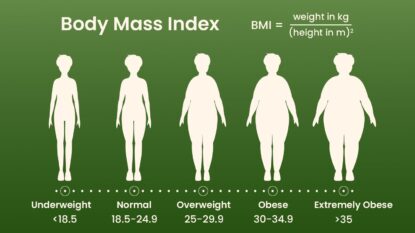World Obesity Day was set up in 2015 to increase our awareness of the growing global obesity crisis. This year the spotlight is on the health systems, government systems, food systems, the media, and the environments we work and live in, rather than us as individuals.
The World Obesity Federation is calling for changes to these systems, which it says are failing us, and for people living with obesity to lead this call.
So why should we care? Probably because obesity is a complex and chronic disease, one which requires lifelong management, and also because it’s a driver of other diseases. According to the World Health Organisation, being very overweight or obese can have a serious impact on health.
Carrying extra fat leads to cardiovascular disease (heart disease and strokes), type 2 diabetes, musculoskeletal disorders like osteoarthritis, and some cancers (endometrial, breast, and colon).
World Obesity Rates – are they increasing?
Obesity rates have been creeping up over time and according to the most recent NHS health survey published in 2024, 2 in 3 adults in the UK are now overweight or obese, with men representing a larger chunk than women, and with this prevalence increasing as we age, reaching its peak between ages of 65-74.
And the global data picture is even grimmer where we expect to see a 100% increase in childhood obesity between 2020 and 2035, the number of adults living with obesity set to double from 2010 to 2035, and nearly 2 billion people living with obesity by 2035.
So, our population is without a doubt carrying a lot of extra weight and it’s fair to say that because so many of us now fit into these categories, we may no longer recognise if someone is overweight or obese.
What do you think ‘obese’ looks like?
If we don’t recognise what an unhealthy weight is, then how can we ever help ourselves? And, as a society, we need to become more aware of what obesity looks like in the flesh, so we can tackle head-on the trouble that lies ahead and take steps towards a healthier way of living.
In our line-up, can you correctly identify where our model moves from a healthy weight to overweight and into the obese category? In this example the woman is 35 years old and 5ft 5in.
A wilderness of mirrors
Do we ever really know how big we are? Mirrors in shops tell lies as blatant as those at funfairs. Then there are those of us with ‘full length mirror phobia’ who might not have looked in the mirror in a while.
We may be aware we could do with losing a few pounds, or even that we might be considered overweight, but we probably don’t realise how ‘small’ obese can be. And those of us who are ‘overweight’ (i.e. not yet obese) are also more likely to continue the same way of life and become obese over time.
Your body mass index equation (BMI) is one way to work out if you’re overweight or obese, and this serves as an early warning for weight-related comorbidities that may develop in the future (where two or more diseases or medical conditions are present at the same time).
However, BMI doesn’t account for muscle mass, so it’s not a definitive diagnostic tool for heavily muscled athletes, for example. Although at a population level, only a miniscule number of people will appear to be obese because of excess muscle.
Know your BMI
So, body mass index (BMI) is a measure of body fat based on your weight in relation to your height. Have you got your calculator ready?
Here’s the calculation:
Divide your weight in kilos by your height in metres squared.
For example, for a woman who is 5ft 5in and weighing 13st her BMI calculation would be:
- 82.5 / (1.65 x 1.65) = 30
The BMI number describes the degree of overweight or obesity as follows:
- Healthy weight — BMI of 18.5-24.9 kg/m2.
- Overweight — BMI of 25-29.9 kg/m2.
- Obesity class 1 — BMI of 30-34.9 kg/m2.
- Obesity class 2 — BMI of 35-39.9 kg/m2.
- Obesity class 3 — BMI of 40 kg/m2 or more.
Remember, there’s 14 lbs to one stone and 12 inches to one foot. And there’s 2.54cm to one inch and 2.2lbs to 1kg.
Frequently asked questions about obesity
Q: What causes obesity?
A: Obesity is a complex issue with a number of causes. Whilst the excess weight is usually the result of consuming more calories, particularly from high-fat and high-sugar foods, than your body uses, other factors including genetics, lack of physical activity, underlying health conditions, and environmental influences all play a role.
Q: What health risks are associated with obesity?
A: Obesity increases the risk of several serious health conditions, including heart disease, type 2 diabetes, certain cancers, and strokes. It can also lead to high blood pressure, sleep apnoea, and osteoarthritis.
Q: Can obesity be treated without surgery or medication?
A: Yes, the good news is that one way obesity can be managed and treated without more extreme interventions is through switching to a very low calorie diet, which will help you lose weight quickly and safely. So there’s no need to go under the knife or prick yourself with needles, you can take back control of your weight and your health yourself.
But I’ve tried lots of diets before and they haven’t worked
Yes, but there’s usually more to losing weight, and keeping it off, than learning how to bake low-fat chocolate cake or counting calories. A key component which isn’t often addressed is what’s actually going on in your head, and understanding why you eat the way you do. Because successful, long term weight loss starts in your mind, not in your mouth.
That’s why TotalFast combines nutritionally complete, very low calorie diet products for effective, safe weight loss, alongside powerful Cognitive Behavioural Therapy (CBT) and Mindfulness techniques to help support your diet plan.
You don’t have to do any calorie counting or think about what to eat, we’ve done it all for you. This means you have the headspace to focus on why you’ve been overeating in the first place.
During the last 30 years, we’ve been privileged and proud to help over a million people transform their lives and start living the new, healthier, lighter ones they deserve.




